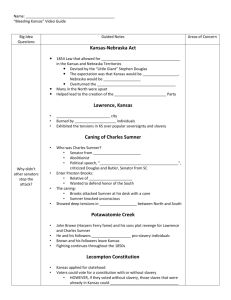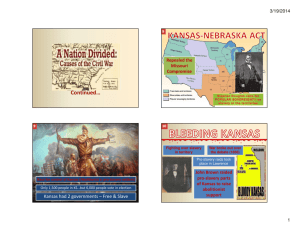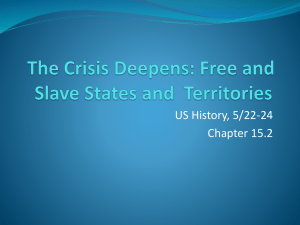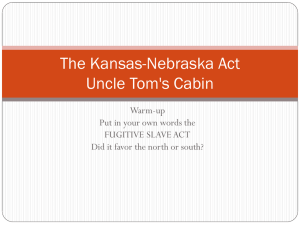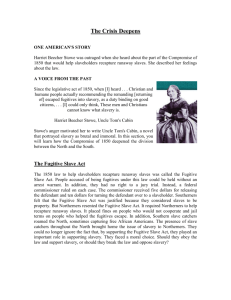The Kansas-Nebraska Act - Immaculateheartacademy.org
advertisement
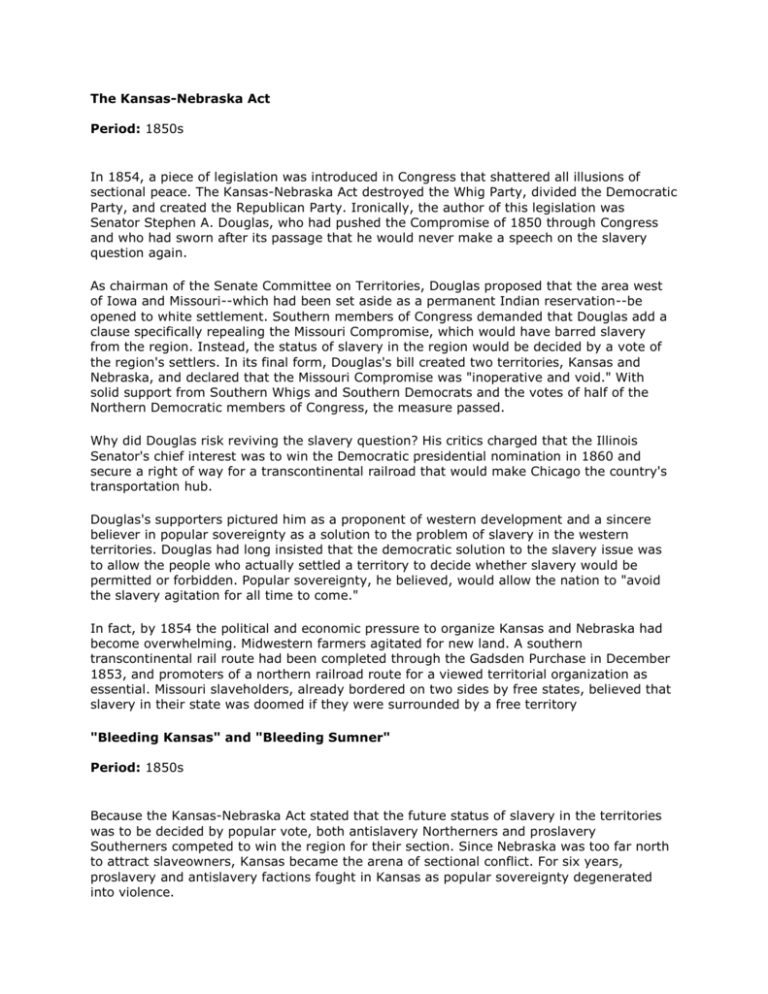
The Kansas-Nebraska Act Period: 1850s In 1854, a piece of legislation was introduced in Congress that shattered all illusions of sectional peace. The Kansas-Nebraska Act destroyed the Whig Party, divided the Democratic Party, and created the Republican Party. Ironically, the author of this legislation was Senator Stephen A. Douglas, who had pushed the Compromise of 1850 through Congress and who had sworn after its passage that he would never make a speech on the slavery question again. As chairman of the Senate Committee on Territories, Douglas proposed that the area west of Iowa and Missouri--which had been set aside as a permanent Indian reservation--be opened to white settlement. Southern members of Congress demanded that Douglas add a clause specifically repealing the Missouri Compromise, which would have barred slavery from the region. Instead, the status of slavery in the region would be decided by a vote of the region's settlers. In its final form, Douglas's bill created two territories, Kansas and Nebraska, and declared that the Missouri Compromise was "inoperative and void." With solid support from Southern Whigs and Southern Democrats and the votes of half of the Northern Democratic members of Congress, the measure passed. Why did Douglas risk reviving the slavery question? His critics charged that the Illinois Senator's chief interest was to win the Democratic presidential nomination in 1860 and secure a right of way for a transcontinental railroad that would make Chicago the country's transportation hub. Douglas's supporters pictured him as a proponent of western development and a sincere believer in popular sovereignty as a solution to the problem of slavery in the western territories. Douglas had long insisted that the democratic solution to the slavery issue was to allow the people who actually settled a territory to decide whether slavery would be permitted or forbidden. Popular sovereignty, he believed, would allow the nation to "avoid the slavery agitation for all time to come." In fact, by 1854 the political and economic pressure to organize Kansas and Nebraska had become overwhelming. Midwestern farmers agitated for new land. A southern transcontinental rail route had been completed through the Gadsden Purchase in December 1853, and promoters of a northern railroad route for a viewed territorial organization as essential. Missouri slaveholders, already bordered on two sides by free states, believed that slavery in their state was doomed if they were surrounded by a free territory "Bleeding Kansas" and "Bleeding Sumner" Period: 1850s Because the Kansas-Nebraska Act stated that the future status of slavery in the territories was to be decided by popular vote, both antislavery Northerners and proslavery Southerners competed to win the region for their section. Since Nebraska was too far north to attract slaveowners, Kansas became the arena of sectional conflict. For six years, proslavery and antislavery factions fought in Kansas as popular sovereignty degenerated into violence. Even before the 1854 act had been passed, Eli Thayer, a businessman and educator from Worcester, Massachusetts, had organized the New England Emigrant Aid Company to promote the emigration of antislavery New Englanders to Kansas to "vote to make it free." By the summer of 1855, more than 9,000 pioneers had settled in Kansas. Slaveholders from Missouri feared that the New England Emigrant Aid Company wanted to convert Kansas into a haven for runaway slaves. One Missouri lawyer told a cheering crowd that he would hang any "free soil" emigrant who came into Kansas. Competition between proslavery and antislavery factions reached a climax on May 30, 1855, when Kansas held territorial elections. Although only 1,500 men were registered to vote, 6,000 ballots were cast, many of them by proslavery "border ruffians" from Missouri. As a result, a proslavery legislature was elected, which passed laws stipulating that only proslavery men could hold office or serve on juries. One statute imposed five years imprisonment for anyone questioning the legality of slavery in Kansas. Free Soilers held their own "Free State" convention in Topeka in the fall of 1855, and drew up a constitution that prohibited slavery in Kansas, and also barred free blacks from the territory. Like the Free Soilers who settled California and Oregon, most Northerners in Kansas wanted the territory to be free and white. They submitted the Topeka Constitution to the territory's voters, who approved it by an overwhelming majority. The Topeka government then asked Congress to admit Kansas as a free state. Kansas now had two legislatures--one pro-slavery, the other against. President Franklin Pierce threw his support behind the proslavery legislature and asked Congress to admit Kansas to the Union as a slave state. Popular sovereignty degenerated into violence. On May 21, 1856, 800 proslavery men, many from Missouri, marched into Lawrence, Kansas, to arrest the leaders of the antislavery government. The posse burned the local hotel, looted a number of houses, destroyed two antislavery printing presses, and killed one man. One member of the posse declared: "Gentlemen, this is the happiest day of my life. I determined to make the fanatics bow before me in the dust and kiss the territorial laws. I have done it, by God." Two days before the "sack of Lawrence," Senator Charles Sumner of Massachusetts began a two-day speech in which he denounced "The Crime Against Kansas." "It is the rape of a virgin territory," he declared, "compelling it to the hateful embrace of slavery.'" The Massachusetts senator proceeded to denounce a number of Southern senators, including Senator Andrew Butler of South Carolina. Sumner accused Senator Butler of taking "the harlot, Slavery," for his "mistress" and proceeded to make fun of a medical disorder from which Senator Butler suffered. At the rear of the Senate chamber, Stephen Douglas muttered: "That damn fool will get himself killed by some other damned fool." Two days later, Senator Butler's nephew, Congressman Preston Brooks of South Carolina, entered a nearly empty Senate chamber. Sighting Sumner at his desk, Brooks charged at him and began striking the Massachusetts senator over the head with a cane. He swung so hard that the cane broke into pieces. Brooks caned Sumner, rather than challenging him to a duel, because he regarded the Senator as his social inferior. Thus, he wanted to use the same method slaveholders used to chastise slaves. Brooks then quietly left the Senate chamber, leaving Sumner "as senseless as a corpse for several minutes, his head bleeding copiously from the frightful wounds, and the blood saturating his clothes." It took Sumner three years to recover from his injuries and return to his Senate seat. Brooks became a hero in the South. Merchants in Charleston, South Carolina, bought Brooks a new cane, inscribed, "Hit him again." A vote to expel Brooks from the House of Representatives failed because every Southern representative but one voted against expulsion. Instead, Brooks was censured. He promptly resigned his seat and was immediately reelected to Congress. In the North, Sumner became a martyr to the cause of freedom. A million copies of Sumner's "Crime Against Kansas" speech were distributed. A young Massachusetts woman summed up popular feeling in the North, condemning Brooks’ assault with these words: "If I had been there I would have torn his eyes out and so I would now if I could." In strife-torn Kansas, John Brown, a devoted Bible-quoting Calvinist who believed he had a personal duty to overthrow slavery, announced that the time had come "to fight fire with fire" and "strike terror in the hearts of proslavery men. The next day, in reprisal for the "sack of Lawrence" and the assault on Sumner, Brown and six companions dragged five proslavery men and boys from their beds at Pottawatomie Creek, split open their skulls with a sword and cut off their hands. A war of revenge erupted in Kansas. Columns of proslavery Southerners ransacked free farms and took "horses and cattle and everything else they can lay hold of" while they searched for Brown and the other "Pottawatomie killers." Armed bands looted enemy stores and farms. At Osawatomie, proslavery forces attacked John Brown's headquarters, leaving a dozen men dead. John Brown's men killed four Missourians, and proslavery forces retaliated by blockading the free towns of Topeka and Lawrence. Before it was over, guerilla warfare in eastern Kansas left 200 dead.


